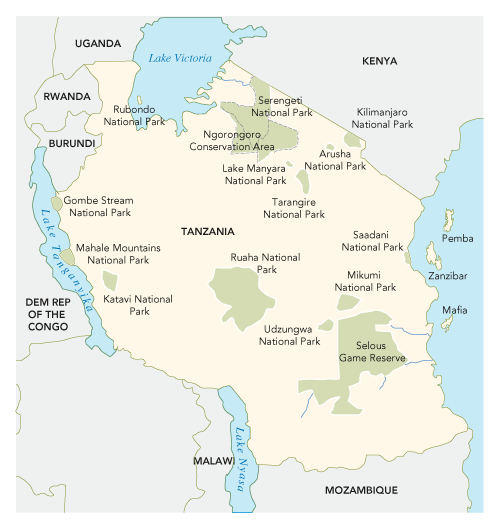SAFARIS
|
It is well known that Tanzania has beautiful nature reserves rich in wildlife that should be visited once in life. We offer safari for the main National Parks with a standard program or customized as per to your needs. You will be accommodated in very confortable tented camp inside the parks or lodge, according with the destination, surrounded by nature and wildlife, if you are lucky you can find some elephant eating near your tent or you can met antelope running on the pathway. You can taste very special local food served under the stars and you can experience the uncontaminated life. Join us to explore the different forms of wildlife and landscapes of Tanzania and meet some of their most fascinating inhabitants. |
 |
SELOUS GAME RESERVE
Selous is the second largest conservation area in Africa sized at 5,000 km2, four times bigger than the Serengeti and UNESCO declared it a world heritage in 1982. It takes its name from Frederic Courtney Selous, a British explorer, who was slain and buried within this Reserve.
Hot volcanic springs, sporadic lakes and channels from the nearby rivers such as the Great Rhuha and Rufiji rivers give Selous Game Reserve a very diversified landscape. Along the Rufiji River you can enjoy the boat safaris sailing on the lakes and channels through to the birds and animals closely including hippos and crocodiles.
A walking safari is also an option to value if you are looking for something very special and different in the Selous game reserve.
The Selous hosts to over 350 species of birds and reptiles, many species of plants and the largest concentration of elephants on the continent have been known for taking home in this same reserve, before the Ivory war. In addition we can find also rhinos, gnus, antelopes, kudus, zebras, giraffes, lions, leopards and the largest populations of buffaloes in Africa. The Wild dogs are some of the key attractions inside the Selous, the good time to observe the scarce wild dogs is during their denning phase from June to August.
The ideal time to observe wildlife in the park is from June to October, during the dry-season, which is easier to see it because the vegetation isn’t thick and the wild animals stand around the water sources. At the end of the heavy rains, the roads are extremely impassable and many of the camps are closed till the end of the wet season.
Towards the end of the dry season especially, you can see many large mammals gather around the five lakes.
In Selous Game Reserve you will experience magnificent safari animals among the breath-taking beauty of the national park.
RUAHA NATIONAL PARK
Ruaha National Park is the largest national park in Tanzania. It covers an area of about 13,000 square kilometres and it takes its name from the Great Ruaha River, which flows along its South-Eastern margin
It is located in the middle of Tanzania about 130 kilometres from Iringa and is part of a more extensive ecosystem, which includes Rungwa Game Reserve, Usangu Game Reserve, and several other protected areas.
Here the short rainfall season begins November to February, while the long season is between March and April and the dry season between June and October.
The park is one of the Tanzania birds’ paradise with more than 571species and some of them are known to be migrants from within and outside Africa.
It seams Ruaha has the higher concentration of elephants than any National Park in East Africa. It is also a place where, magnificent mammals like Kudu, Sable and Roan antelopes can easily be spotted in Miombo woodland and the habitat for endangered wild dogs. You can find lions, leopards, cheetah, giraffes, zebras, elands, impala, bat eared foxes and Jackals as well as a number of reptiles and amphibians such as crocodiles, poisonous and non-poisonous snakes, monitor lizards, agama lizards and frogs
The park is characterized by semi-arid type of vegetation, baobab trees, Acacia and other species. There are over 1,650 plant species that have been identified.
NGORONGORO CONSERVATION AREA
The Ngorongoro Conservation Area covers 8,292 square kilometres. It is one of the three divisions that comprise Ngorongoro District in Arusha Region and it was designated to promote the conservation of natural resources, safeguard the interests of indigenous residents and promote tourism.
The Ngorongoro Conservation Area is the only site in the world with a high concentration of wildlife living in harmony with human communities.
It includes the Ngorongoro Crater, The Serengeti Plains that support about 2.0 millions migratory wildlife species of the Serengeti Mara-ecosystem and the catchment forest: the Northern Highland Forest. Other important items found in the Ngorongoro Conservation Area are the Olduvai Gorge archaeological site, regarded as the cradle of mankind and the most important prehistoric site in the world, and the early human foot-prints that were discovered at Alaitole in Ngarusi area that testify the harmonious co-existence between wildlife and people that has existed for many years.
Ngorongoro Conservation Area was accorded the status of a World Heritage Site by UNESCO since 1979.
The area contains a big amount of large animals and 26 black rhinoceros. There are wildebeests, zebras, eland and Grant's and Thomson's gazelles. The crater also hosts the densest population of lions, in the rainforests of the crater rim, you can find leopards, large elephants, buffalos, spotted hyenas, rare wild dogs, cheetahs, and other felines and over 500 species of bird.
The entire area offers a breath-taking landscape of lush and varied vegetation from grassy plains to evergreen forests and arid and semi-arid zones.
SERENGETI NATIONAL PARK
The Serengeti was discovered in 1923 by the American hunter Stewart Edward White, who left from Nirobi for an excursion and found himself in the land that the Masai call Siringitu, "the place where the earth moves forever", which defined paradise.
The Serengeti region encompasses the Serengeti National Park itself, the Ngorongoro Conservation Area, Maswa Game Reserve, the Loliondo, Grumeti and Ikorongo Controlled Areas and the Maasai Mara National Reserve in Kenya. and hosts one of the oldest ecosystems in world whose climate has barely changed over the past million years.
The Serengeti is famous for the migration, every year about 200,000 zebras and over a million gnus, move from the north to the southern plains in the period of the short rains, between October and November, and then swirl west and north after the long rains in April, May and June.
Its territory is characterized by a great vairety of landscapes and ecosystems that will leave you breathless.
SADANI
Saadani's originality lies in its position along the Indian Ocean, with huge sandy beaches, frequented only by seabirds and, during spawning, by sea turtles giants.
Many ruminants and primates can be seen during safaris and hikes in Saadani, especially giraffes, buffaloes, warthogs and various antelopes such as cobes, hartebeest, wildebeest, kudu, elk and even the magnificent and rare black seahorse. The permanent presence of game naturally attracts predators and several lions, leopards and hyenas have established their territory in the Park. The stay in Saadani is particularly aimed at lovers of Tanzania or the curious looking for different experiences.
Contact us for a free quote and programs information.


















